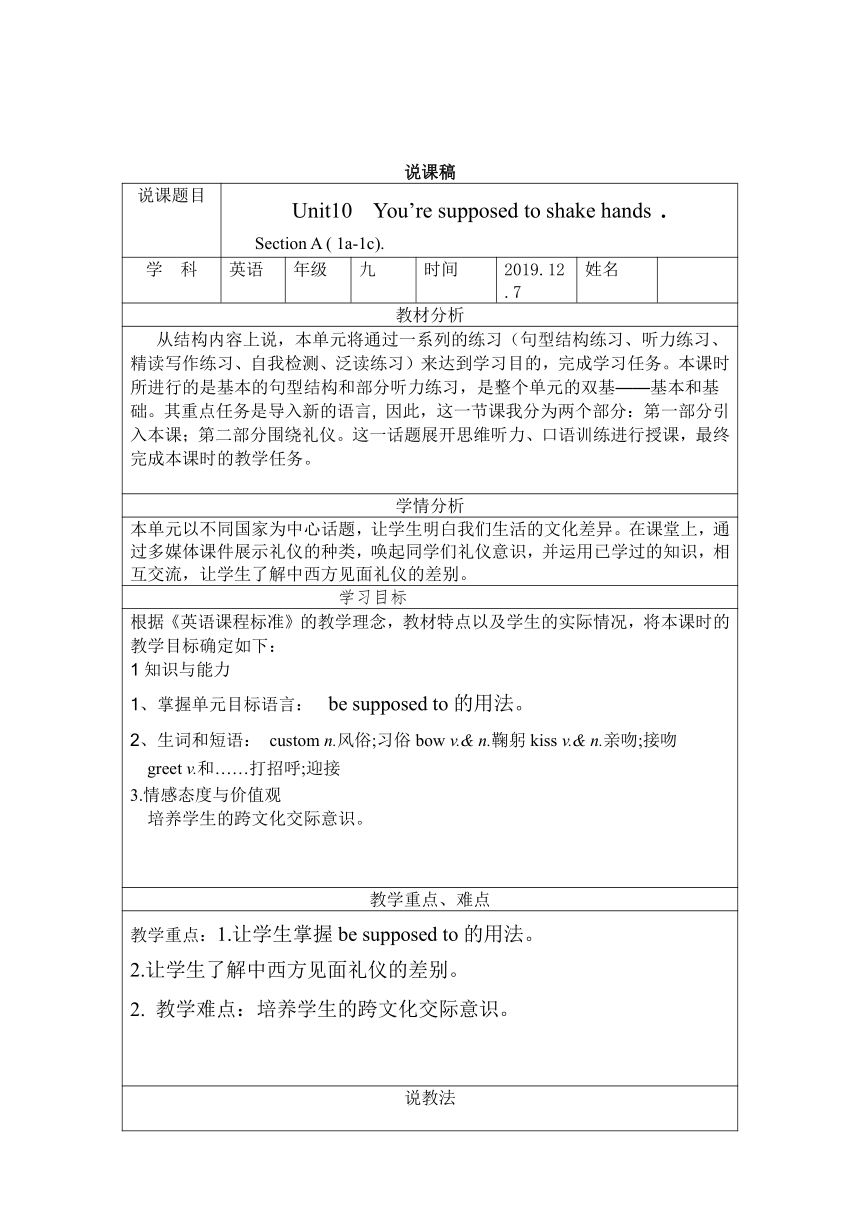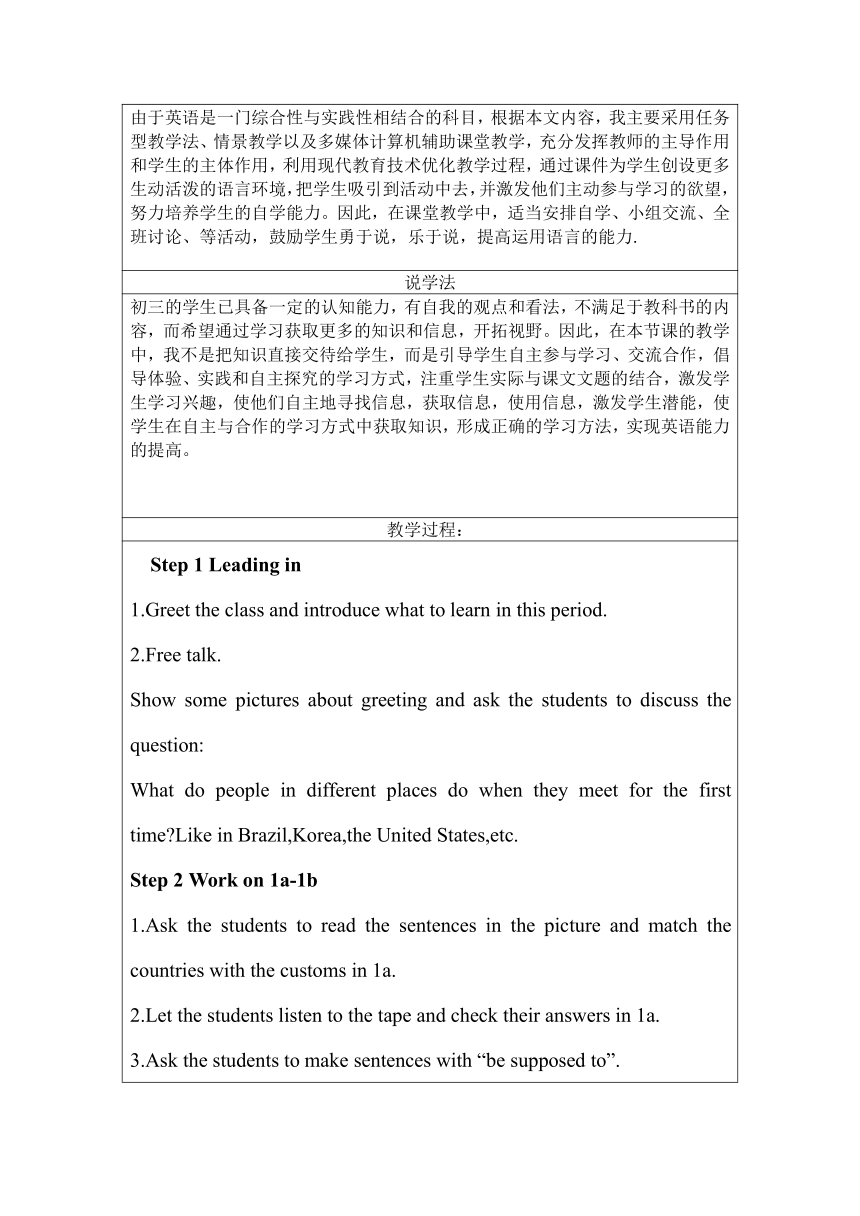Unit10 You’re supposed to shake hands Section A ( 1a-1c).说课稿
文档属性
| 名称 | Unit10 You’re supposed to shake hands Section A ( 1a-1c).说课稿 |  | |
| 格式 | zip | ||
| 文件大小 | 48.0KB | ||
| 资源类型 | 教案 | ||
| 版本资源 | 人教新目标(Go for it)版 | ||
| 科目 | 英语 | ||
| 更新时间 | 2020-01-10 18:41:09 | ||
图片预览


文档简介
说课稿
说课题目 Unit10 You’re supposed to shake hands . Section A ( 1a-1c).
学 科 英语 年级 九 时间 2019.12.7 姓名
教材分析
从结构内容上说,本单元将通过一系列的练习(句型结构练习、听力练习、精读写作练习、自我检测、泛读练习)来达到学习目的,完成学习任务。本课时所进行的是基本的句型结构和部分听力练习,是整个单元的双基——基本和基础。其重点任务是导入新的语言, 因此,这一节课我分为两个部分:第一部分引入本课;第二部分围绕礼仪。这一话题展开思维听力、口语训练进行授课,最终完成本课时的教学任务。
学情分析
本单元以不同国家为中心话题,让学生明白我们生活的文化差异。在课堂上,通过多媒体课件展示礼仪的种类,唤起同学们礼仪意识,并运用已学过的知识,相互交流,让学生了解中西方见面礼仪的差别。
学习目标
根据《英语课程标准》的教学理念,教材特点以及学生的实际情况,将本课时的教学目标确定如下: 1知识与能力1、掌握单元目标语言:k be supposed to的用法。2、生词和短语: custom n.风俗;习俗bow v.& n.鞠躬kiss v.& n.亲吻;接吻greet v.和……打招呼;迎接 3.情感态度与价值观培养学生的跨文化交际意识。
教学重点、难点
教学重点:1.让学生掌握be supposed to的用法。 2.让学生了解中西方见面礼仪的差别。 2. 教学难点:培养学生的跨文化交际意识。
说教法
由于英语是一门综合性与实践性相结合的科目,根据本文内容,我主要采用任务型教学法、情景教学以及多媒体计算机辅助课堂教学,充分发挥教师的主导作用和学生的主体作用,利用现代教育技术优化教学过程,通过课件为学生创设更多生动活泼的语言环境,把学生吸引到活动中去,并激发他们主动参与学习的欲望,努力培养学生的自学能力。因此,在课堂教学中,适当安排自学、小组交流、全班讨论、等活动,鼓励学生勇于说,乐于说,提高运用语言的能力.
说学法
初三的学生已具备一定的认知能力,有自我的观点和看法,不满足于教科书的内容,而希望通过学习获取更多的知识和信息,开拓视野。因此,在本节课的教学中,我不是把知识直接交待给学生,而是引导学生自主参与学习、交流合作,倡导体验、实践和自主探究的学习方式,注重学生实际与课文文题的结合,激发学生学习兴趣,使他们自主地寻找信息,获取信息,使用信息,激发学生潜能,使学生在自主与合作的学习方式中获取知识,形成正确的学习方法,实现英语能力的提高。
教学过程:
Step 1 Leading in 1.Greet the class and introduce what to learn in this period. 2.Free talk. Show some pictures about greeting and ask the students to discuss the question: What do people in different places do when they meet for the first time?Like in Brazil,Korea,the United States,etc.Step 2 Work on 1a-1b 1.Ask the students to read the sentences in the picture and match the countries with the customs in 1a. 2.Let the students listen to the tape and check their answers in 1a. 3.Ask the students to make sentences with “be supposed to”.Step 3 Work on 1c Show some pictures and ask the students to make conversations based on the information in 1a. S1:What are people in Korea/Japan...supposed to do when they meet for the first time? S2:They’re supposed to bow...Step 4 Work on 2a-2b 1.Play the recording for the first time.Let the students listen and find out the mistakes Maria made in 2a.Check the answers. 2.Play the recording a second time and let the students listen again and then fill in the blanks in 2b. 3.Check the answers with the whole class.Read the full sentences in 2b together.Step 5 Work on 2c 1.Focus on the conversation in 2c.Make the students scan the conversation first. 2.Teach and then make the students role-play the conversation in pairs. 3.Have a pair of students present their conversation to the class.Step 6 Work on 2d 1.Let the students read the conversation and answer the following questions: Where did John go last night? What are Japanese expected to do when they meet? What are people supposed to do when they see each other in France? 2.Play the recording and get the students to follow the recording.Then ask the students to act out the conversation in pairs. 3.Invite three pairs to show their conversations in front of the whole class
板书设计
1.be supposed to do “本应,本该” 2.expect 作动词,意为“预料;期待”。常见用法: expect to do sth.(=look forward to doing sth.)期望做某事 expect sb.to do sth.期待某人做某事 3.as soon as 意为“一……就……”,
说课题目 Unit10 You’re supposed to shake hands . Section A ( 1a-1c).
学 科 英语 年级 九 时间 2019.12.7 姓名
教材分析
从结构内容上说,本单元将通过一系列的练习(句型结构练习、听力练习、精读写作练习、自我检测、泛读练习)来达到学习目的,完成学习任务。本课时所进行的是基本的句型结构和部分听力练习,是整个单元的双基——基本和基础。其重点任务是导入新的语言, 因此,这一节课我分为两个部分:第一部分引入本课;第二部分围绕礼仪。这一话题展开思维听力、口语训练进行授课,最终完成本课时的教学任务。
学情分析
本单元以不同国家为中心话题,让学生明白我们生活的文化差异。在课堂上,通过多媒体课件展示礼仪的种类,唤起同学们礼仪意识,并运用已学过的知识,相互交流,让学生了解中西方见面礼仪的差别。
学习目标
根据《英语课程标准》的教学理念,教材特点以及学生的实际情况,将本课时的教学目标确定如下: 1知识与能力1、掌握单元目标语言:k be supposed to的用法。2、生词和短语: custom n.风俗;习俗bow v.& n.鞠躬kiss v.& n.亲吻;接吻greet v.和……打招呼;迎接 3.情感态度与价值观培养学生的跨文化交际意识。
教学重点、难点
教学重点:1.让学生掌握be supposed to的用法。 2.让学生了解中西方见面礼仪的差别。 2. 教学难点:培养学生的跨文化交际意识。
说教法
由于英语是一门综合性与实践性相结合的科目,根据本文内容,我主要采用任务型教学法、情景教学以及多媒体计算机辅助课堂教学,充分发挥教师的主导作用和学生的主体作用,利用现代教育技术优化教学过程,通过课件为学生创设更多生动活泼的语言环境,把学生吸引到活动中去,并激发他们主动参与学习的欲望,努力培养学生的自学能力。因此,在课堂教学中,适当安排自学、小组交流、全班讨论、等活动,鼓励学生勇于说,乐于说,提高运用语言的能力.
说学法
初三的学生已具备一定的认知能力,有自我的观点和看法,不满足于教科书的内容,而希望通过学习获取更多的知识和信息,开拓视野。因此,在本节课的教学中,我不是把知识直接交待给学生,而是引导学生自主参与学习、交流合作,倡导体验、实践和自主探究的学习方式,注重学生实际与课文文题的结合,激发学生学习兴趣,使他们自主地寻找信息,获取信息,使用信息,激发学生潜能,使学生在自主与合作的学习方式中获取知识,形成正确的学习方法,实现英语能力的提高。
教学过程:
Step 1 Leading in 1.Greet the class and introduce what to learn in this period. 2.Free talk. Show some pictures about greeting and ask the students to discuss the question: What do people in different places do when they meet for the first time?Like in Brazil,Korea,the United States,etc.Step 2 Work on 1a-1b 1.Ask the students to read the sentences in the picture and match the countries with the customs in 1a. 2.Let the students listen to the tape and check their answers in 1a. 3.Ask the students to make sentences with “be supposed to”.Step 3 Work on 1c Show some pictures and ask the students to make conversations based on the information in 1a. S1:What are people in Korea/Japan...supposed to do when they meet for the first time? S2:They’re supposed to bow...Step 4 Work on 2a-2b 1.Play the recording for the first time.Let the students listen and find out the mistakes Maria made in 2a.Check the answers. 2.Play the recording a second time and let the students listen again and then fill in the blanks in 2b. 3.Check the answers with the whole class.Read the full sentences in 2b together.Step 5 Work on 2c 1.Focus on the conversation in 2c.Make the students scan the conversation first. 2.Teach and then make the students role-play the conversation in pairs. 3.Have a pair of students present their conversation to the class.Step 6 Work on 2d 1.Let the students read the conversation and answer the following questions: Where did John go last night? What are Japanese expected to do when they meet? What are people supposed to do when they see each other in France? 2.Play the recording and get the students to follow the recording.Then ask the students to act out the conversation in pairs. 3.Invite three pairs to show their conversations in front of the whole class
板书设计
1.be supposed to do “本应,本该” 2.expect 作动词,意为“预料;期待”。常见用法: expect to do sth.(=look forward to doing sth.)期望做某事 expect sb.to do sth.期待某人做某事 3.as soon as 意为“一……就……”,
同课章节目录
- Unit 1 How can we become good learners.
- Section A
- Section B
- Unit 2 I think that mooncakes are delicious!
- Section A
- Section B
- Unit 3 Could you please tell me where the restroom
- Section A
- Section B
- Unit 4 I used to be afraid of the dark.
- Section A
- Section B
- Unit 5 What are the shirts made of?
- Section A
- Section B
- Review of Units 1-5
- Unit 6 When was it invented?
- Section A
- Section B
- Unit 7 Teenagers should be allowed to choose their
- Section A
- Section B
- Unit 8 It must belong to Carla.
- Section A
- Section B
- Unit 9 I like music that I can dance to.
- Section A
- Section B
- Unit 10 You're supposed to shake hands.
- Section A
- Section B
- Review of Units 6-10
- Unit 11 Sad movies make me cry.
- Section A
- Section B
- Unit 12 Life is full of the unexpected
- Section A
- Section B
- Unit 13 We're trying to save the earth!
- Section A
- Section B
- Unit 14 I remember meeting all of you in Grade 7.
- Section A
- Section B
- Review of Units 11-14
